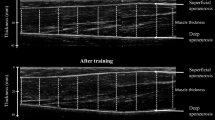Abstract
There is a paucity of research into the importance of performing strength training exercises in postures specific to the movements they are attempting to facilitate. In addressing this question, 27 previously trained subjects were randomly allocated into heavy weight training and control groups. The weight training group performed 4–6 sets of 6–10 repetitions of the squat and bench press lifts twice a week for 8 weeks. Prior to and after the training period the following tests were conducted: bench press throw at 30% of maximal load, vertical jump, maximal squat and bench press lifts, push-up test performed over a force platform, 40-m sprint, 6-s cycle, and isokinetic tests assessing upper and lower body musculature in varying actions. The results supported the concept that posture is important in training as those exercises conducted in similar postures to the training recorded the greatest improvement in performance. For example, after completion of the training the weight training subjects significantly increased by approximately 12% the maximal load lifted in the bench press exercise and the peak torque in the isokinetic bench press test. However, performance in the isokinetic horizontal arm adduction test was not significantly changed. We speculate that the phenomenon of posture specificity may, at least in part, be caused by the differing postures altering the neural input to the musculature. The results stress the importance of selecting exercises in which the posture closely resembles that of the movements they are attempting to facilitate.
Similar content being viewed by others
References
Baker D, Wilson GJ, Carlyon B (1994) Periodization: the effect of manipulating volume and intensity upon strength. J Strength Cond Res 8:235–242
Caiozzo VJ, Perrine JJ, Edgerton VR (1981) Training induced alterations in the force-velocity curve. J Appl Physiol 51:750–754
Colliander EB, Tesch PA (1990) Effects of eccentric and concentric muscle actions in resistance training. Acta Physiol Scand 140:31–39
Colliander EB, Tesch PA (1992) Effects of detraining following short term resistance training on eccentric and concentric muscle strength. Acta Physiol Scand 144:23–29
Ewing JL, Wolfe DR, Rogers MA, Admundson ML, Stull GA (1990) Effects of velocity of isokinetic training on strength, power, and quadriceps muscle fibre characteristics. Eur J Appl Physiol 61:159–162
Hakkinen K, Alen M, Komi PV (1985a) Electromyographic and muscle fibre characteristics of human skeletal muscle during strength training and detraining. Acta Physiol Scand 125:573–585
Hakkinen K, Komi PV, Alen M (1985b) Effect of explosive type strength training on isometric force- and relaxation-time, electromyographic and muscle fibre characteristics of leg extensor muscles. Acta Physiol Scand 125:587–600
Hortobagyi T, Katch F, LaChance P (1989) Interrelationships among various measures of upper body strength assessed by different contraction modes. Eur J Appl Physiol 58:749–755
Kanehisa H, Miyashita M (1983) Specificity of velocity in strength training. Eur J Appl Physiol 52:104–106
Lindh M (1979) Increase of muscle strength from isometric quadriceps exercises at different knee angles. Scand J Rehabil Med 11:33–36
MacDougall JD, Wenger HA, Green HJ (1982) Physiological testing of the elite athlete. Canadian Association of Sport Sciences, Human Kinetics, Champaign, IL, pp 7–37
Murphy AJ, Wilson GJ, Pryor JF (1994) The use of the iso inertial force mass relationship in the prediction of dynamic human performance. Eur J Appl Physiol 69:250–257
Pearl B (1986) Getting stronger. Pearl and Shelter Publications, pp 82–175
Pearson R (1974) Rhythmic activity of a group of human motoneurons during voluntary contraction of a muscle. Electroencephalogr Clin Neurophysiol 36:585–595
Peterson S, Miller H, Quinney H, Wenger H (1984) The acquisition of muscular strength: the influence of training velocity and initial VO2 max. Can J Sport Sci 9:176–180
Pipes TV, Wilmore JH (1975) Isokinetic vs isotonic strength training in adult men. Med Sci Sports 7:262–274
Rasch PJ, Morehouse LE (1957) Effect of static and dynamic exercises on muscular strength and hypertrophy. J Appl Physiol 11:29–34
Signorile JF, Weber B, Roll B, Caruso JF, Lowensteyen I, Perry AC (1994) An electromyographical comparison of the squat and knee extension exercises. J Strength Cond Res 8:178–183
Stone MH, O'Bryant H, Garhammer J (1981) A hypothetical model for strength training. J Sports Med 21:342–351
Ter Haar Romeny B, Denier van der Gon J, Gielen C (1982) Changes in recruitment order of motor units in the human biceps muscle. Exp Neurol 78:360–368
Ter Haar Romeny B, Denier van der Gon J, Gielen C (1984) Relation between location of a motor unit in the human biceps brachii and its critical firing levels for different tasks. Exp Neurol 85:631–650
Willoughby D (1992) A comparison of three selected weight training programs on the upper and lower body strength of trained males. Appl Res Coach Athlet Ann March: 124–146
Wilson GJ, Elliott BC, Wood GA (1992) Stretch shorten cycle performance enhancement through flexibility training. Med Sci Sports Exerc 24:116–123
Wilson GJ, Newton RU, Murphy AJ, Humphries BJ (1993) The optimal training load for the development of dynamic atheltic performance. Med Sci Sports Exerc 25:1279–1286
Wilson GJ, Murphy AJ, Pryor JF (1994): Musculo-tendinous stiffness: its relationship to eccentric, isomeric and concentric performance. J Appl Physiol 76:2714–2719
Author information
Authors and Affiliations
Rights and permissions
About this article
Cite this article
Wilson, G.J., Murphy, A.J. & Walshe, A. The specificity of strength training: the effect of posture. Europ. J. Appl. Physiol. 73, 346–352 (1996). https://doi.org/10.1007/BF02425497
Accepted:
Issue Date:
DOI: https://doi.org/10.1007/BF02425497




